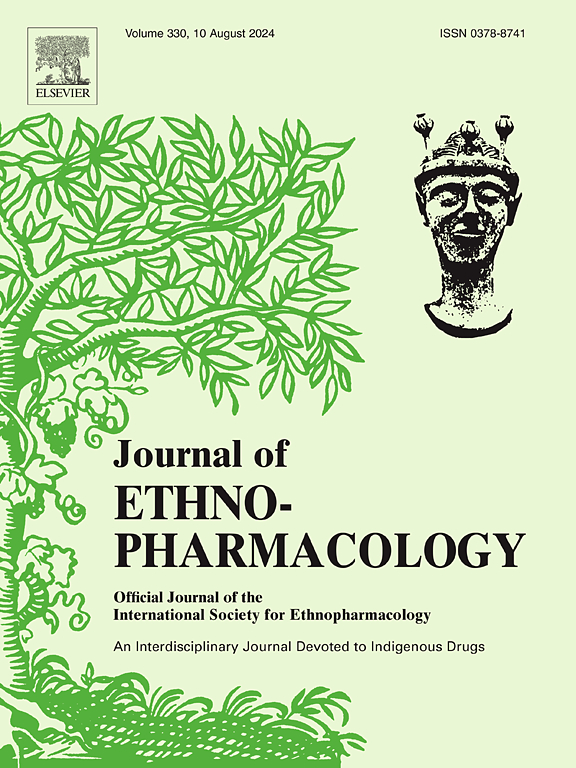巴西莲子的肾保护和利尿作用昆参叶提取物;急性和亚急性毒性评估。
IF 4.8
2区 医学
Q1 CHEMISTRY, MEDICINAL
引用次数: 0
摘要
民族药理学相关性:巴西莲藕(L.)紫红科的紫子在巴西和印度的传统医学实践中被广泛使用,因为它具有促进利尿的功效,以及治疗伤口、炎症、产后症状、腹泻和咳嗽。选择它作为本研究的对象不仅是因为它的民族医学意义,还因为它丰富的植物化学成分,包括黄酮类化合物、皂苷和生物碱等生物活性化合物,已知它们具有保护肾脏和利尿的作用。此外,虽然苋菜科的许多物种都表现出类似的治疗特性,但在这方面,巴西苋仍未得到充分的研究。因此,本研究旨在科学评价其潜在的肾保护和利尿作用,为其传统应用提供药理学依据。研究目的:研究巴西莲子对顺铂所致大鼠肾损伤的保护作用和利尿作用。本研究还通过急性和亚急性毒性试验来评价植物提取物的毒性。材料与方法:本研究采用顺铂诱导大鼠肾损伤后,评价巴西木水乙醇提取物对肾脏的保护作用。提取物分75 mg/kg、150 mg/kg和300 mg/kg三种剂量给药。通过与对照和标准品(速尿)的比较,还进行了利尿活性测定。提取物分75 mg/kg、150 mg/kg和300 mg/kg三种剂量给药。在2000 mg/kg和3000 mg/kg剂量下进行了为期14天的急性毒性评估试验,在250 mg/kg、500 mg/kg和1000 mg/kg剂量下进行了为期28天的亚急性毒性评估试验。采用高效液相色谱法对其生物活性成分进行了鉴定和测定。结果:巴西木水乙醇提取物(ABAE)对大鼠顺铂毒性作用有保护作用。这种提取物还能增加尿量。ABAE的保护作用随着剂量的增加而增强,在剂量为300 mg/kg时肾保护作用和利尿作用最大。急性毒性试验结果表明,LD50大于3000 mg/kg,在亚急性毒性试验中,250 mg/kg、500 mg/kg和1000 mg/kg剂量均未发生拮抗作用。从组织病理学、血液学和血清生化分析可以看出,ABAE对肾、肝和心脏组织没有毒性。ABAE的HPLC-DAD分析表明,ABAE中含有甜菜素、山酚、没食子酸、对香豆酸和草酸。结论:巴西木提取物中含有丰富的生物活性物质,在改善肾功能的同时减少不良反应应予以考虑。本文章由计算机程序翻译,如有差异,请以英文原文为准。

Nephroprotective and diuretic effect of Alternanthera brasiliana (L.) Kuntze leaf extract; acute and sub-acute toxicity assessment
Ethnopharmacological relevance
Alternanthera brasiliana (L.) Kuntze of the family Amaranthaceae has been extensively used in traditional medicinal practices in Brazil and India for its reputed efficacy in promoting diuresis, as well as treating wounds, inflammation, postnatal symptoms, diarrhea, and cough. Its selection for this study was driven not only by its ethnomedicinal significance but also by its rich phytochemical composition, including bioactive compounds such as flavonoids, saponins, and alkaloids, which are known to exhibit nephroprotective and diuretic effects. Additionally, while many species from the Amaranthaceae family have demonstrated similar therapeutic properties, A. brasiliana remains underexplored in this context. Therefore, this research aimed to scientifically evaluate its potential nephroprotective and diuretic activities, providing a pharmacological basis for its traditional uses.
Aim of study
This experiment was designed to determine nephroprotective effect against cisplatin-induced kidney injury and diuretic effect of Alternanthera brasiliana (L.) in rats. This study also aimed to evaluate the toxicity of plant's extract by performing acute and sub-acute toxicity trials.
Material and methods
In current study, the nephroprotective effect of aqueous-ethanol extract of A. brasiliana was evaluated after induction of kidney injury with cisplatin. Extract was given in three doses as 75 mg/kg, 150 mg/kg and 300 mg/kg. A diuretic activity was also performed by comparing results with control and standard (furosemide). Extract was given in three doses as 75 mg/kg, 150 mg/kg and 300 mg/kg. A 14 day trial for acute toxicity assessment was performed at doses 2000 mg/kg and 3000 mg/kg, whereas a 28 day trial for sub-acute toxicity assessment was performed at doses 250 mg/kg, 500 mg/kg and 1000 mg/kg. The biological active ingredients were identified and determined using HPLC technique.
Results
The aqueous-ethanol extract of A. brasiliana (ABAE) safeguarded the rats from toxic effects of cisplatin. This extract also enhanced urine output. The protective effect of ABAE increased with increasing dose and produced maximum nephroprotective effect and diuresis at a dose 300 mg/kg. The outcomes from acute toxicity trials suggested that LD50 lied beyond 3000 mg/kg, and no antagonizing effects occurred in sub-acute toxicity trials at doses 250 mg/kg, 500 mg/kg and 1000 mg/kg. ABAE posed no toxicities on kidney, liver, and heart tissues as evident from histopathological, hematological, and serum biochemical analysis. HPLC-DAD analysis of ABAE indicated the presence of betanin, kaempherol, gallic acid, p-coumaric acid and oxalic acid.
Conclusions
These results demonstrate an abundant supply of bioactive chemicals found in A. brasiliana (L.) extracts, which should be taken into account to improve renal functions with fewer negative effects.
求助全文
通过发布文献求助,成功后即可免费获取论文全文。
去求助
来源期刊

Journal of ethnopharmacology
医学-全科医学与补充医学
CiteScore
10.30
自引率
5.60%
发文量
967
审稿时长
77 days
期刊介绍:
The Journal of Ethnopharmacology is dedicated to the exchange of information and understandings about people''s use of plants, fungi, animals, microorganisms and minerals and their biological and pharmacological effects based on the principles established through international conventions. Early people confronted with illness and disease, discovered a wealth of useful therapeutic agents in the plant and animal kingdoms. The empirical knowledge of these medicinal substances and their toxic potential was passed on by oral tradition and sometimes recorded in herbals and other texts on materia medica. Many valuable drugs of today (e.g., atropine, ephedrine, tubocurarine, digoxin, reserpine) came into use through the study of indigenous remedies. Chemists continue to use plant-derived drugs (e.g., morphine, taxol, physostigmine, quinidine, emetine) as prototypes in their attempts to develop more effective and less toxic medicinals.
 求助内容:
求助内容: 应助结果提醒方式:
应助结果提醒方式:


